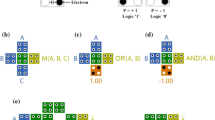Abstract
CMOS technology is facing physical limitations in scaling the manufacturing process. Therefore, to deepen the development of better designs in a smaller area, it is necessary to look for other alternatives. One of the most studied approaches is Quantum Cellular Automata (QCA). However, it has the disadvantage of its reliability during the manufacturing processes, with high error rates that are difficult to improve. To contribute to the design of more reliable operators based on this technology, new fault-tolerant full-adders are presented in this paper. The proposed solutions improve area up to 57.14%, total energy dissipation up to 36.27%, and average energy dissipation per cycle up to 36.22% compared to those previously proposed. This reduction in power consumption is especially important to make QCA more competitive as it has to operate in low-temperature environments.






























Similar content being viewed by others
Notes
Note that, comparisons to CMOS technology are omitted as it is outside of this work’s scope and is already analyzed in the literature by other authors.
References
Powell JR (2008) The Quantum Limit to Moore’s Law. Proc IEEE 96(8):1247. https://doi.org/10.1109/JPROC.2008.925411
Soares T, Nizer Rahmeier J, Lima V, Augusto Lascasas Freitas L, Melo L, Vilela Neto O (2018) NMLSim: a nanomagnetic logic (NML) circuit designer and simulation tool. J Comput Electron 17:1370. https://doi.org/10.1007/s10825-018-1215-8
Gu Z, Nowakowski ME, Carlton D, Storz R, Hong J, Chao W, Lambson B, Bennett P, Alam MT, Marcus MA, Doran A, Young A, Scholl A, Bokor J (2014) Speed and reliability of nanomagnetic logic technology, arXiv : Mesoscale and Nanoscale Physics
Wolkow RA, Livadaru L, Pitters J, Taucer M, Piva P, Salomons M, Cloutier M, Martins BVC (2014) Silicon Atomic Quantum Dots Enable Beyond-CMOS Electronics, Field-Coupled Nanocomputing: Paradigms, Progress, and Perspectives (Springer Berlin Heidelberg), pp. 33–58. https://doi.org/10.1007/978-3-662-43722-3-3
Karunaratne DK, Bhanja S (2012) Study of single layer and multilayer nano-magnetic logic architectures. J Appl Phys 111(7):07A928. https://doi.org/10.1063/1.3676052
Lent CS, Tougaw PD, Porod W, Bernstein GH (1993) Quantum cellular automata. Nanotechnol 4(1):49. https://doi.org/10.1088/0957-4484/4/1/004
Orlov A, Amlani I, Bernstein G, Lent CS, Snider GL (1997) Realization of a functional cell for quantum-dot cellular automata. Sci 277(5328):928. https://doi.org/10.1126/science.277.5328.928
Farazkish R, Sayedsalehi S, Navi K (2012) Novel design for quantum dots cellular automata to obtain fault-tolerant majority gate. J Nanotechnol. https://doi.org/10.1155/2012/943406
Walus K, Dysart TJ, Jullien GA, Budiman RA (2004) QCADesigner: a rapid design and Simulation tool for quantum-dot cellular automata. IEEE Trans Nanotechnol 3(1):26. https://doi.org/10.1109/TNANO.2003.820815
Torres FS (2015) Manual for QCADesigner-Energy (QD-E). github.com/FSillT/QCADesigner-E/blob/master/ManualQDE.pdf
Patterson JLHD (2018) Computer Organization and Design: The Hardware / Software Interface (RISC-V Edition) (Morgan Kaufmann)
Hauck ADS (2008) Reconfigurable Computing: The Theory and Practice of FPGA-Based Computation (Morgan Kaufmann)
Safoyev N, Jeon J (2018) Coplanar QCA adders for arithmetic circuits. Int J Eng Technol (UAE) 7:15. https://doi.org/10.14419/ijet.v7i4.4.19597
Safoyev N, Jeon JC (2020) Design and evaluation of cell interaction based vedic multiplier using quantum-dot cellular automata, Electron 9(6). https://doi.org/10.3390/electronics9061036
Rasouli Heikalabad S, Salimzadeh F, Zirak Barughi Y (2020) A unique three-layer full adder in quantum-dot cellular automata. Comput Electr Eng.
Ahmadpour SS, Mosleh M, Rasouli Heikalabad S (2019) Robust QCA full-adders using an efficient fault-tolerant five-input majority gate. Int J Circuit Theory Appl 47:1037. https://doi.org/10.1002/cta.2634
Abedi D, Jaberipur G, Sangsefidi M (2015) Coplanar full adder in quantum-dot cellular automata via clock-zone-based crossover. IEEE Trans Nanotechnol 14(3):497. https://doi.org/10.1109/TNANO.2015.2409117
Mokhtari D, Rezai A, Rashidi H, Rabiei F, Emadi S, Karimi A (2018) Design of novel efficient full adder architecture for Quantum-dot Cellular Automata technology. FACTA UNIVERSITATIS Ser Electron Energ. https://doi.org/10.2298/FUEE1802279M
Ahmadpour SS, Mosleh M, Rasouli Heikalabad S (2020) The design and implementation of a robust single-layer QCA ALU using a novel fault-tolerant three-input majority gate. J Supercomput 76:10155. https://doi.org/10.1007/s11227-020-03249-3
Liu W, Zhang T, McLarnon E, O’Neill M, Montuschi P, Lombardi F (2019) Design and Analysis of Majority Logic Based Approximate Adders and Multipliers, IEEE Transactions on Emerging Topics in Computing pp. 1–5. https://doi.org/10.1109/TETC.2019.2929100
Niemier M (2004) Designing digital systems in quantum cellular automata. Ph.D. thesis, University of Notre Dame
Reis D (2016) Robustness analysis and enhancement strategies for quantum-dot cellular automata structures. Ph.D. thesis
Danehdaran F, Bagherian Khosroshahy M, Navi K, Bagherzadeh N (2018) Design and power analysis of new coplanar one-bit full-adder cell in quantum-dot cellular automata. J Low Power Electron 14:38. https://doi.org/10.1166/jolpe.2018.1529
Kavitha SS, Kaulgud N (2017) Quantum dot cellular automata (QCA) design for the realization of basic logic gates, pp. 314–317. https://doi.org/10.1109/ICEECCOT.2017.8284519
Shin S, Jeon JC, Kee-Young Y (2014) Design of wire-crossing technique based on difference of cell state in quantum-dot cellular automata. Int J Control Autom. https://doi.org/10.14257/ijca.2014.7.4.14
Hosseinzadeh H, Heikalabad SR (2018) A novel fault tolerant majority gate in quantum-dot cellular automata to create a revolution in design of fault tolerant nanostructures, with physical verification. Microelectron Eng 192(C):52. https://doi.org/10.1016/j.mee.2018.01.019
Du H, Hongjun L (2016) Design and analysis of new fault-tolerant majority gate for quantum-dot cellular automata. J Comput Electron 15:1484. https://doi.org/10.1007/s10825-016-0918-y
Kumar D, Mitra D (2016) Design of a practical fault-tolerant adder in QCA. Microelectron J 53:90. https://doi.org/10.1016/j.mejo.2016.04.004
Sun M, Lv H, Zhang Y, Xie GJ (2018) the fundamental primitives with fault-tolerance in quantum-dot cellular automata. J Electron Test 34:1. https://doi.org/10.1007/s10836-018-5723-z
Farazkish R (2018) Novel efficient fault-tolerant full-adder for quantum-dot cellular automata. Int J Nano Dimens 9(1):58
Wang X, Xie G, Deng F, Quan Y, Lü H (2018) Design and comparison of new fault-tolerant majority gate based on quantum-dot cellular automata, J Semicond 39(8). https://doi.org/10.1088/1674-4926/39/8/085001
Ahmadpour SS, Mosleh M (2019) New designs of fault-tolerant adders in quantum-dot cellular automata. Nano Commun Netw 19:10. https://doi.org/10.1016/j.nancom.2018.11.001
Moghimizadeh T, Mosleh M (2019) A novel design of fault-tolerant RAM cell in quantum-dot cellular automata with physical verification. J Supercomput 75:5688. https://doi.org/10.1007/s11227-019-02812-x
Author information
Authors and Affiliations
Corresponding author
Additional information
Publisher's Note
Springer Nature remains neutral with regard to jurisdictional claims in published maps and institutional affiliations.
Rights and permissions
About this article
Cite this article
Bravo-Montes, J.A., Martín-Toledano, A., Sánchez-Macián, A. et al. Design and implementation of efficient QCA full-adders using fault-tolerant majority gates. J Supercomput 78, 8056–8080 (2022). https://doi.org/10.1007/s11227-021-04247-9
Accepted:
Published:
Issue Date:
DOI: https://doi.org/10.1007/s11227-021-04247-9




